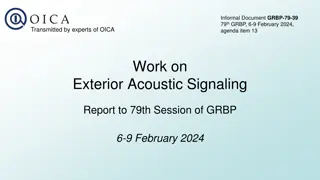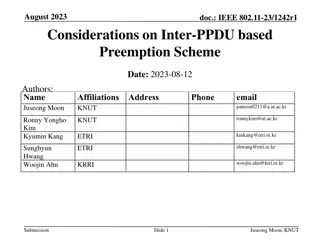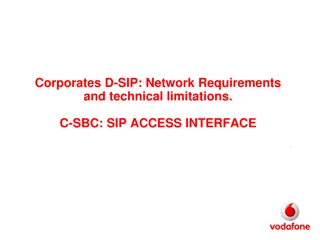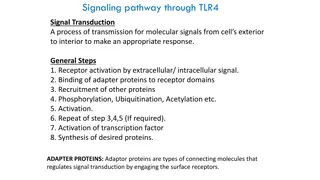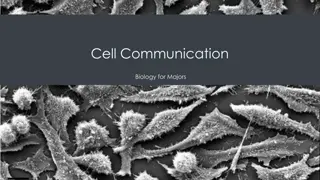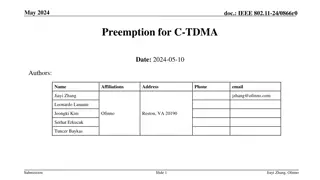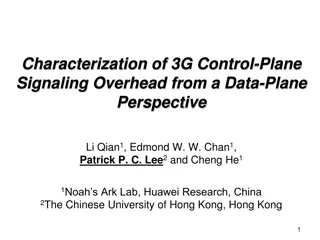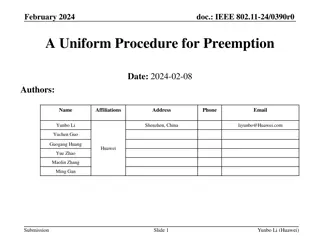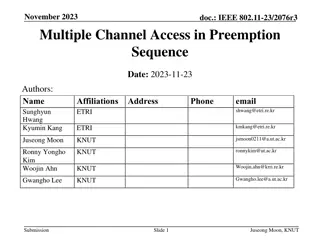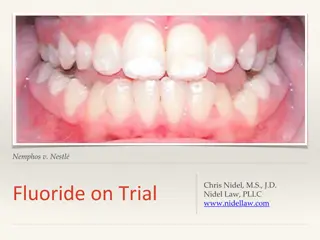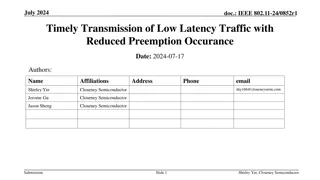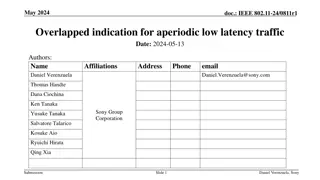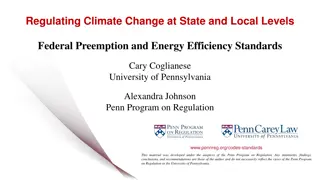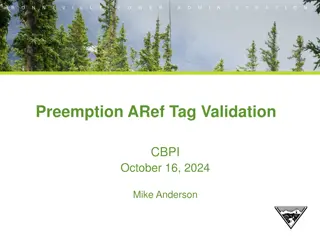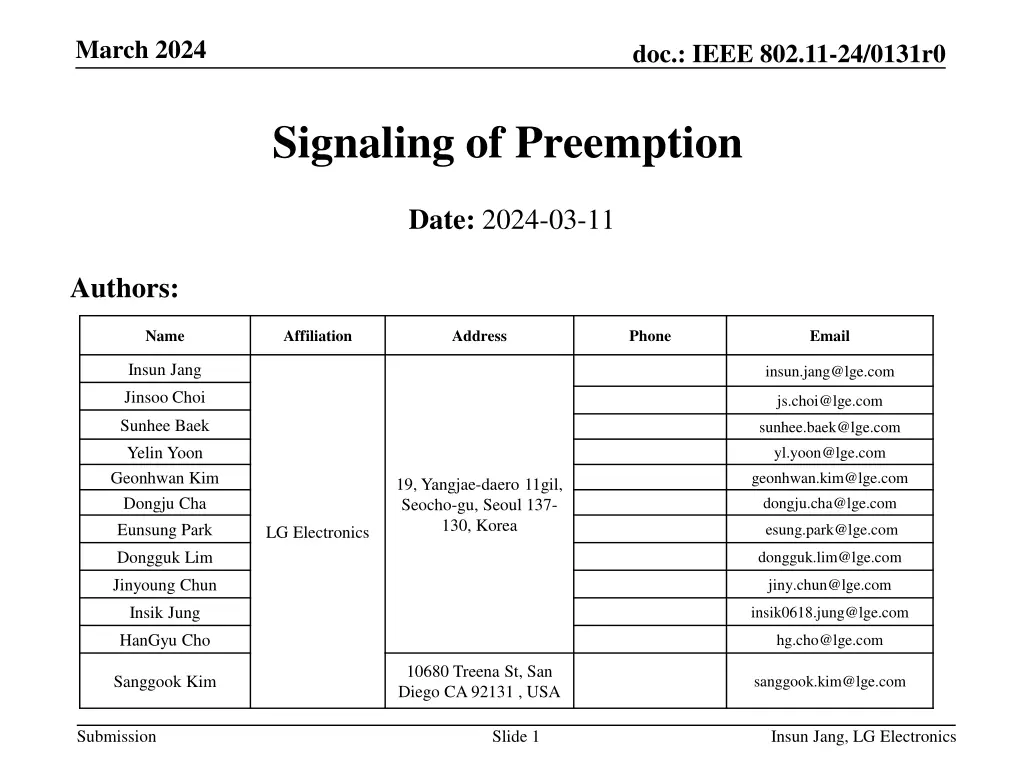
IEEE 802.11-24/0131r0 Signaling of Preemption Overview
Explore the detailed design proposal for achieving preemption in the IEEE 802.11-24/0131r0 document through steps involving soliciting LLT presence, identifying STAs with LLT info, and triggering preemption. The document discusses the use of TF-based preemption and Proposal #1 to define dedicated RA-RU for preemption in DL TXOP scenarios.
Download Presentation

Please find below an Image/Link to download the presentation.
The content on the website is provided AS IS for your information and personal use only. It may not be sold, licensed, or shared on other websites without obtaining consent from the author. If you encounter any issues during the download, it is possible that the publisher has removed the file from their server.
You are allowed to download the files provided on this website for personal or commercial use, subject to the condition that they are used lawfully. All files are the property of their respective owners.
The content on the website is provided AS IS for your information and personal use only. It may not be sold, licensed, or shared on other websites without obtaining consent from the author.
E N D
Presentation Transcript
March 2024 doc.: IEEE 802.11-24/0131r0 Signaling of Preemption Date: 2024-03-11 Authors: Name Affiliation Address Phone Email Insun Jang Jinsoo Choi insun.jang@lge.com js.choi@lge.com Sunhee Baek Yelin Yoon Geonhwan Kim Dongju Cha Eunsung Park Dongguk Lim Jinyoung Chun Insik Jung HanGyu Cho sunhee.baek@lge.com yl.yoon@lge.com geonhwan.kim@lge.com dongju.cha@lge.com 19, Yangjae-daero 11gil, Seocho-gu, Seoul 137- 130, Korea esung.park@lge.com LG Electronics dongguk.lim@lge.com jiny.chun@lge.com insik0618.jung@lge.com hg.cho@lge.com 10680 Treena St, San Diego CA 92131 , USA Sanggook Kim sanggook.kim@lge.com Submission Slide 1 Insun Jang, LG Electronics
March 2024 doc.: IEEE 802.11-24/0131r0 Introduction We shared our high-level views in [1] for achieving preemption and also other contributions [2]-[5] has similar approaches Triggering Info indicates at least a TXOP holder asks if the TXOP responder(s) and other STA(s) needs to transmit LLT in its TXOP LLT Info indicates at least it has LLT to be transmitted in the current TXOP In this contribution, we propose detailed design for preemption Submission Slide 2 Insun Jang, LG Electronics
March 2024 doc.: IEEE 802.11-24/0131r0 Overview of Preemption Step Generally, we can use one or more following steps based on several proposals and depending on signaling design Step 1: TXOP holder solicits LLT presence from one or more associated STA(s) Step 2: TXOP holder identifies the STA(s) with LLT Info (e.g., buffer status) Step 3: TXOP holder solicits LLT from the STAs (DL TXOP) or TXOP responder transmits LLT (UL TXOP) We proposes the details of preemption signaling step by step Submission Slide 3 Insun Jang, LG Electronics
March 2024 doc.: IEEE 802.11-24/0131r0 Step 1 Step 3 At once: TF-based Preemption Trigger frame (TF) is a good candidate since it already has been well-designed for triggering one or more STA(s) to transmit something TF can go through Step 1 - Step 3 at once, i.e., TF triggers LLT It basically can identify STAs It can be transmitted solely or with QoS Data frame (e.g., using broadcast RU) It can allocate RA-RU(s) only for associated STAs since TXOP holder doesn t know which STA has LLT In addition, some RUs can be allocated to specific STAs (baseline) Issue: Existing RA-RU can be accessed by all STAs supporting it regardless of LLT presence It wouldn t achieve the goal of preemption especially in environments of many such STAs Submission Slide 4 Insun Jang, LG Electronics
March 2024 doc.: IEEE 802.11-24/0131r0 Proposal #1 Proposal #1: Defines Dedicated RA-RU for Preemption It should be only for DL TXOP (i.e., TXOP holder = AP) We can use a special AID (similar to current RA-RU allocation) It shall be accessed by the STA supporting preemption, i.e., understanding the RU If a STA supporting preemption doesn t have LLT, it doesn t transmit anything It does not require any modifications to fields of TF, which allows for pre-11bn or 11bn STAs not supporting preemption to allocate resources simultaneously Submission Slide 5 Insun Jang, LG Electronics
March 2024 doc.: IEEE 802.11-24/0131r0 Step 1 Step 2 At once + Step 3: TF-based Preemption TXOP holder may first identifies STA(s) having LLT with LLT Info and then solicits LLT LLT Info can be BSR to check buffer status, for which we can still keep Proposal #1 to solicit BSR for preemption STAs only Another existing information could be considered (e.g., NFR (see Appendix #1)) New LL-specific information (e.g., delay bound, enqueue time) could be designed, but it can flexibly be used not only for preemption (not addressed here) It helps the TXOP holder to allocate resources optimally/properly while requiring additional frame exchange *BA may not be present Submission Slide 6 Insun Jang, LG Electronics
March 2024 doc.: IEEE 802.11-24/0131r0 Discussion on TF-based Preemption TF can schedule a preemption with DL/UL for pre-UHR STAs or UHR STAs not supporting preemption In terms of frame exchange, overhead can be reduced without any other frames Pre-UHR PPDUs including TF can be used AP can adjust the number and locations of RA-RU depending on BSS environments TF would work for preemption enough, but depending on the cases, some issues may exist, e.g., It may lead to waste of RA-RU continuously, especially if any STAs do not have LLT in a TXOP In case of Tx with Data, TF may not be able to be transmitted due to available bandwidth or some UHR STAs may not receive TF for preemption due to unsupported bandwidth Submission Slide 7 Insun Jang, LG Electronics
March 2024 doc.: IEEE 802.11-24/0131r0 Step 1 + Step 2 + Step 3: PHY header Proposal #2: Define an indication in PHY header to solicit preemption requests (PRs) It first checks if there are STAs having LLT It can be included SIG-field in PHY header of UHR PPDU (e.g., including data to TXOP responder) It solicits equally configured response simultaneously (e.g., CTS) from one or more UHR STAs having LLT It can allow UHR STAs to transmit their PR only when PHY header is decoded (with failure of MAC part) It can be used for UL TXOP Submission Slide 8 Insun Jang, LG Electronics
March 2024 doc.: IEEE 802.11-24/0131r0 Proposal #3 (Cont d) In DL TXOP, AP can follow steps mentioned in the previous slides to identify STAs and transmit LLT after PR reception To identify STAs with LLT Info check, we can utilize BSRP (see Proposal #1) NFRP discussion is shown in Appendix #1 May not be present Submission Slide 9 Insun Jang, LG Electronics
March 2024 doc.: IEEE 802.11-24/0131r0 Proposal #3 for UL TXOP In UL TXOP, we need to consider how to transmit PR Proposal #3: Defining an indication in BlockAck frame for PR It can be efficient, i.e., Ack + PR rather than sole PR frame (to be defined) It can be utilized to inform TXOP holder an intent of preemption, e.g., Without soliciting preemption request, it requests to enable preemption With soliciting preemption request, it responds to enable preemption and transmits LLT It could be used by a non-AP STA in DL TXOP We could consider an another way [1] if we don t use PHY header (Appendix #2) Submission Slide 10 Insun Jang, LG Electronics
March 2024 doc.: IEEE 802.11-24/0131r0 PIFS rule for Preemption In DL TXOP, an AP can expect no PR from any STA (from Proposal #2) [1] In this case, the AP can continue a PPDU PIFS after preceding PPDU Moreover, it is straightforward to require CCA during PIFS to differentiate between PR and no PR/failure Proposal #4: PIFS is allowed between PPDUs soliciting preemption request if no PR is received and CCA during PIFS is required In UL TXOP, we don t need such a rule by Proposal #3 since it can continue SIFS-separated frame exchanges Even though BA with preemption request fails, a STA can identify the AP is transmitting LLT during recovery procedure Submission Slide 11 Insun Jang, LG Electronics
March 2024 doc.: IEEE 802.11-24/0131r0 Conclusion In this contribution, we proposed as follows. Proposal #1: Defines Dedicated RA-RU for Preemption (for DL) Proposal #2: Define an indication in PHY header to solicit PR (for DL/UL) Proposal #3: Defining an indication in BlockAck frame for PR (for UL) Proposal #4: PIFS is allowed between PPDUs soliciting PR if no PR is received and CCA during PIFS is required (for DL) We can have some observations Without Proposal #2 (UHR PPDU), TF-based preemption (Proposal #1) can be utilized with the schedule including pre-UHR STAs With Proposal #2 (UHR PPDU), Proposal #1 can be combined to identify STAs with LLT Info With Proposal #3, efficient preemption in UL TXOP is performed With Proposal #4 in DL TXOP, we can handle no PR or failure cases while in UL TXOP it is not needed Submission Slide 12 Insun Jang, LG Electronics
March 2024 doc.: IEEE 802.11-24/0131r0 Appendix #1: Usage of NFRP TF From Proposal #2 and #3 in DL TXOP, we may utilize NFRP TF instead of BSRP or LLRP It is clearly different in terms of resource allocation (i.e., TB feedback) It requires that all STAs for preemption implement TB feedback It would be required to modify the current NFRP based on some observations, e.g., Staring AID (+ # of STAs) may not cover all STAs that transmitted a PR Current Feedback type without any modifications to NFRP TF would allow STAs supporting NFR to respond Whether the usage of NFRP TF for preemption is proper or not should be discussed Submission Slide 13 Insun Jang, LG Electronics
March 2024 doc.: IEEE 802.11-24/0131r0 Appendix #2: Another way in UL TXOP As an alternative without an indication of PHY header, the STA may transmit a triggering frame that enables LLT TX from the AP It is based on that the AP may inform the TXOP holder (STA 1) of LLT presence, through BA frame (with PR) It could help the STA grant its TXOP to the AP Submission Slide 14 Insun Jang, LG Electronics
March 2024 doc.: IEEE 802.11-24/0131r0 Straw Poll 1 Do you agree to include the following into the 11bn SFD? 11bn defines an RA-RU to allow an UHR STA supporting preemption to access Variant of Trigger frame that can allocate the RA-RU is Basic and BSRP Submission Slide 15 Insun Jang, LG Electronics
March 2024 doc.: IEEE 802.11-24/0131r0 Straw Poll 3 Do you agree to include the following into the 11bn SFD? 11bn define an indication in PHY header included in UHR PPDU for a STA to solicit a preemption request Preemption request means the STA has low latency traffic to be transmitted Submission Slide 16 Insun Jang, LG Electronics
March 2024 doc.: IEEE 802.11-24/0131r0 Straw Poll 4 Do you agree to include the following into the 11bn SFD? 11bn defines an indication in BlockAck frame for preemption request Preemption request means the STA has low latency traffic to be transmitted Submission Slide 17 Insun Jang, LG Electronics
March 2024 doc.: IEEE 802.11-24/0131r0 Straw Poll 5 Do you agree to include the following into the 11bn SFD? An AP can transmit a PPDU PIFS after transmitting a preceding PPDU soliciting PR if there was no PR in response to the preceding PPDU and the AP shall CCA during PIFS Submission Slide 18 Insun Jang, LG Electronics
March 2024 doc.: IEEE 802.11-24/0131r0 References [1] 11-23/1909, Transmission Method of Low Latency Traffic [2] 11-23/1886, Preemption techniques to meet low-latency (LL) targets [3] 11-24/0103, TXOP level preemption for Low latency application in 802.11bn [4] 11-24/0168, TXOP Preemption in 11bn [5] 11-24/0390, A Uniform Procedure for Preemption Submission Slide 19 Insun Jang, LG Electronics


